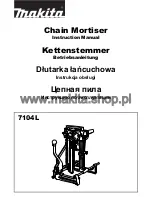
Synchronisation to velocity
TS5055
11
Version: 1.3
3
Synchronisation to velocity
Under synchronization to velocity, a slave axis, starting in any state, is synchronized as quickly as possible
to a moving master axis. The synchronous velocity of the slave here is given by the master velocity multiplied
by the coupling factor.
The synchronization phase of the slave axis is calculated in such a way that the
specified by the user are maintained. Calculation and checking of these boundary conditions is carried out
under the assumption that the master axis will continue to move without acceleration after the coupling time.
If the master axis is not free moving, some overshoot or undershoot of the parameterized boundary
conditions may occur.
Example 1:
In the illustrated phase 0 (left) the two axes are moving entirely independently. The future master axis is
accelerating to 500 mm/s while the future slave axis is accelerating to -250 mm/s. As the phase changes
from 0 to 2 the process of synchronization to velocity in the Universal Flying Saw starts (StartSync = 1) and
the set value profile for the synchronization is calculated. This calculated set value profile for the slave is
then specified for phase 2 of the slave axis. At the end of phase 2 the slave axis precisely achieves the
synchronous velocity, which is the velocity of the master axis multiplied by the coupling factor. From this time
on the axes are in the synchronous phase (phase 3). In this synchronous phase the two axes move
synchronously in accordance with the coupling factor. The synchronous phase is ended by the uncoupling
command. In the illustration, this corresponds to the transition from phase 3 to phase 0. From this time on
they are again two independent master axes. The slave axis changes to a master axis online at the
uncoupling time. This online change will remove any acceleration or deceleration to which the slave may be
subject, thus fixing the velocity of the former slave, with which it will then continue to move without limit.
The phase currently applying to the slave axis can be seen in the nAxisState variable in the cyclic axis
interface. (The names of the individual phases in the illustrations do not agree with the values of the
variable.)
(* Start parameters *)
fMasterVelo := 500;
fSlaveVelo := -250;
(* Coupling parameters *)
fGearRatio := 1.0;
fSlaveAcc := 2500;
fSlaveDec := 2500;
fSlaveJerk := 5000;
Содержание TS5055
Страница 1: ...Manual EN TS5055 TwinCAT 2 NC Flying Saw 2022 11 22 Version 1 3...
Страница 2: ......
Страница 4: ...Table of contents TS5055 4 Version 1 3...
Страница 31: ...Interfaces TS5055 31 Version 1 3 ADS interface Documentation of the ADS interface...
Страница 43: ...PLC API TS5055 43 Version 1 3 Type definition for the characteristic parameters of a flying saw synchronization...
Страница 46: ......












































